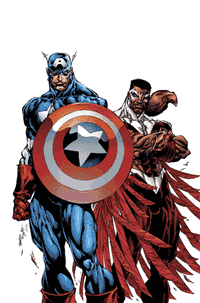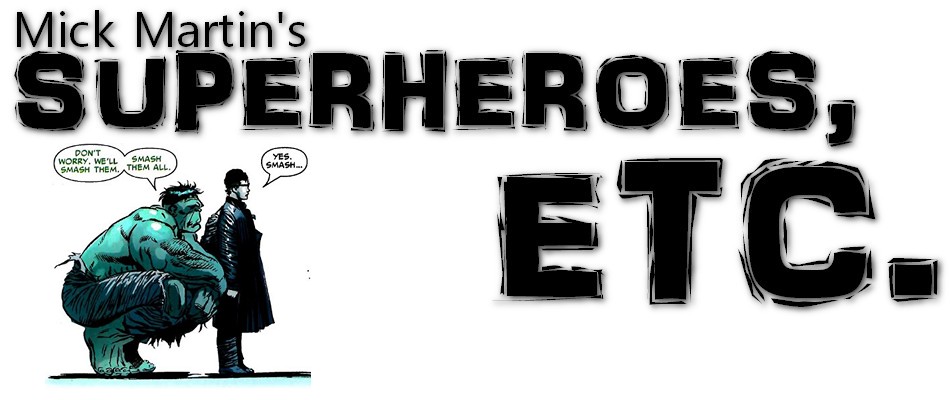 Captain America and The Falcon #s 1-3
Captain America and The Falcon #s 1-3By Christopher Priest, Bart Sears,
Rob Hunter, and Mike Atiyeh
Published by Marvel Comics
Phrases like, "critical acclaim, poor sales," and "the best comic you’re not reading," have become the official mantras of fans of Christopher Priest, one of the industry’s enduring underdogs. The number of titles canceled during Priest’s watch has given rise to the "Priest Curse" superstition which, according to Priest, while only a joke to most, infects the perceptions of not only some fans, but a few unnamed comics professionals as well. As far as paranormal conspiracy belief goes, it rates right up there with the morons who circulated posts over the Internet that Chris Claremont – with The Fantastic 4th Voyage of Sinbad – had predicted the 9/11 disaster. Titles featuring household names like The Ray and Quantum and Woody hardly need supernatural intervention to get the axe. The announcement that Christopher Priest was given a shot at the new series Captain America and The Falcon, a title with at least one marquee Marvel character, was a welcome one.
For the most part, Priest is at the top of his game with Captain America and The Falcon. The book bears little resemblance to the 70's title of the same name (the regular Captain America title was renamed Captain America and The Falcon in 1971, with The Falcon’s name removed in 1975). The new title is a conspiracy thriller in superhero clothes, and it blurs the nature of the relationship between The Falcon and his star-spangled mentor. The plot is as suspenseful and engaging as the best of Tom Clancy’s novels, and ambiguity of Cap and Falcon’s respective positions plunges the story that much deeper into mystery.
Non-linear storytelling seems to be one of Priest’s favorite scripting tools, but many readers who gave Black Panther a test-drive complained it made the plots too confusing. It’s been tamed a bit with Captain America and The Falcon. The first three issues of the series use just enough time-shifting to heighten the suspense without frustrating the reader. It’s good to see Priest making the title more accessible to new readers without abandoning the style entirely.
Priest jumps right into the mystery in the first issue, without any real intro to the characters, apparently trusting the readers are familiar enough with the key players. It succeeds in getting the suspense on the ground and running, but it’s a risk. Cap may be a recognizable enough figure, but Falcon, not so much. It almost feels like this was originally conceived as a limited series rather than an ongoing monthly. Time will tell whether or not Priest’s trust in the readers will pay off.
Priest isn’t new to conspiracy stories; they were one of the hallmarks of his run on Black Panther, but instead of the Atlantean wars, magical golden frogs, and time-traveling Kirby clones of that late title, Cap and Falcon deal with a plot much more grounded in reality. It involves an infamous Cuban drug cartel, a loose-cannon spook who shares Cap’s uniform but none of his moral scruples, and a dangerous new weapon everyone’s trying to get their hands on.
There are times when the less "super" nature of the story doesn’t work. With his motives and intentions clouded, Falcon sometimes comes off as more of a super-spy than a superhero. In Falcon’s first non-flashback appearance in the first issue, for example, his feet are propped up on a desk as he fingers an unlit cigar in one hand and aims a pistol at members of the Cuban drug cartel in the other. You could get away with a scene like that with the Punisher. Maybe Batman. Maybe. But a guy in a bright white-and-red suit, sporting a feathered flying machine on his back, with a golden beak perched on the bridge of his nose trying to come off like a Tarantino bad-ass? Nah, that doesn’t work.
The primary aspect of the title that keeps it from reaching its full potential is the penciling. Whether you love the art of Bart Sears or hate it, it’s clear he wasn’t the right penciller for this series. There isn’t enough subtlety in his work to adequately portray any of the real world aspects of the tale and his habit of flanking the panels with profile shots of the main characters only breeds confusion. The exaggerated humanity of his renderings work best in the more "super" moments of the story, such as when Falcon is caught in hurricane winds at the end of the second issue, or his battle with the so-called "Anti-Cap" at the end of the third. The fourth issue will be Sears’s last, with Joe Bennett (who Priest worked with on The Crew) taking over the penciling.
Captain America and The Falcon is rich with potential, and it’s certainly one of the more suspenseful of Marvel’s titles. Hopefully, the change in the creative team will help the book be all it can and should be.

No comments:
Post a Comment